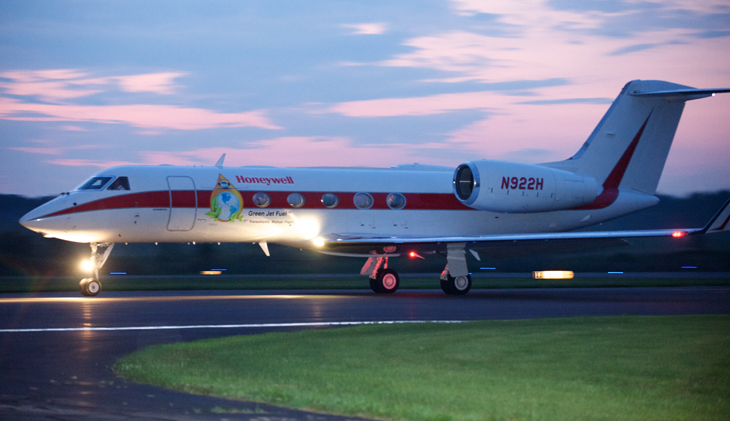HONEYWELL GREEN JET FUEL POWERS FIRST-EVER TRANSATLANTIC BIOFUEL FLIGHT
- Use of Honeywell Green Jet Fuel saves 5.5 metric tons of net carbon dioxide emissions
- Green Jet Fuel now one step closer to commercial use with initial ASTM approval
- Honeywell biofuel and aviation technologies drive down flight costs, increasing profits and reducing carbon footprints
Honeywell announced that its Green Jet Fuel has successfully powered the first transatlantic biofuel flight, which landed at Paris-Le Bourget Airport.
The Honeywell-operated Gulfstream G450 became the first aircraft to fly from North America to Europe with a 50/50 blend of Honeywell Green Jet Fuel and petroleum-based jet fuel, powering one of the aircrafts Rolls-Royce engines. It was also the first business jet to be powered by a biofuel.
The biofuel was derived from camelina, a dedicated energy crop that does not compete in the food chain as it grows in rotation with wheat acreage and can also grow on marginal land. The feedstock for this flight was grown and harvested by Sustainable Oils, a U.S.-based producer of camelina-based technology.
The flight departed Morristown, N.J., at 9 p.m. Friday June 18, 2011 and arrived in Paris about seven hours after takeoff. The jet closely followed the route taken by Charles Lindbergh’s famous first flight across the Atlantic.
Based on lifecycle analyses, use of Honeywell Green Jet Fuel on the flight saved approximately 5.5 metric tons of net carbon dioxide emissions compared to the same flight powered by petroleum-based fuel.
This first biofuel trip across the Atlantic, along with more than a dozen other commercial and military test flights conducted to date, demonstrates that Honeywell Green Jet Fuel more than meets the demanding requirements for air travel, said Jim Rekoske, vice president and general manager of Renewable Energy and Chemicals for Honeywells UOP. Now that the initial ASTM International approval is in place, we are one step closer to commercial use that will help the aviation community reduce its carbon footprint and dependence on crude.
“Gulfstream is committed to achieving business aviation’s ambitious goals on emissions reductions,” said Pres Henne, senior vice president, Programs, Engineering and Test for Gulfstream. “These include carbon neutral growth by 2020 and a reduction in total carbon emissions of 50 percent by 2050 relative to 2005. We are working with engine companies and other innovators, such as Honeywell, to ensure we can meet these initiatives. We are very proud to participate in this historic demonstration.”
Advancing New Sources of Fuel to Reduce Aviation Emissions
Fluctuating fuel prices combined with increased restrictions in aviation emissions regulations drive the demand for alternative sources of fuel. Honeywell Green Jet Fuel is a sustainable fuel option that meets all specifications for flight without any modifications to the aircraft or engine.
Honeywell has produced more than 700,000 gallons of Honeywell Green Jet Fuel from sustainable, inedible sources such as camelina, jatropha and algae for use in commercial and military testing. In each of the 16 biofuel flights conducted to date, Honeywell Green Jet Fuel proved that it meets all specifications for flight on military and commercial platforms without any modification to the aircraft or engines.
The process to produce Green Jet Fuel was originally developed in 2007 under a contract from the U.S. Defense Advanced Research Projects Agency (DARPA) to produce renewable military jet fuel. The process is based on hydro-processing technology commonly used in today’s refineries to produce transportation fuels. It produces an aviation biofuel that can be blended seamlessly with petroleum-based fuel.
With more than 500,000 gallons produced, camelina-based renewable jet fuel has been the most widely tested of any feedstock and has proven itself on more engine types and aircraft, said Tom Todaro, CEO of Sustainable Oils. It’s the only sustainable feedstock that is widely and commercially available today. We are proud to partner with Honeywell on this historic flight

Driving Down Airlines Cost of Operations and Reducing Carbon Footprint
In addition to biofuels, Honeywell offers a range of technologies to help airlines reduce fuel costs — the largest single operating cost for airlines.
Reducing both the cost of operations and carbon emissions has never been more imperative. From advanced avionics to sustainable biofuel and energy efficient jet engines, innovations from Honeywell are addressing these needs today, aids Plane View cockpit helped the aircraft fly the most fuel efficient and direct route from Morristown.
Honeywell technologies also support worldwide air traffic modernization efforts to make flights safer, more fuel efficient, and can lower emissions. Honeywells Air Traffic Management technologies and Flight Management Systems (FMS) also help to shorten flight times, increase flight efficiency and safety through precision navigation and landing systems; and minimize airport delays and carbon footprint.
Honeywells newly certified advanced traffic collision avoidance system (TCAS) solution with SmartTraffic can significantly reduce cost of operations for airlines. SmartTraffic incorporates In Trail Procedure (ITP), designed to allow planes to fly closer together and land more efficiently without sacrificing safety. The ability to simply change routes can enable fuel savings of up to $100,000 per year, per aircraft.
